![]()
![]()
![]()
Use LEFT and RIGHT arrow keys to navigate between flashcards;
Use UP and DOWN arrow keys to flip the card;
H to show hint;
A reads text to speech;
38 Cards in this Set
- Front
- Back
- 3rd side (hint)
|
Infancy |
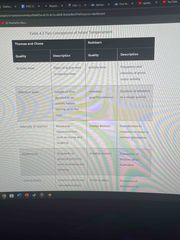
The first year of life. It has the fastest growth in the first year, triple the weight. It stops significantly and they loose a lot of baby fat. Height growth irregular (about a inch per month but when it happens is completely random so one time a day then 2 weeks then 3 days ), bursts and lulls. Similar growth patterns across countries for first 6 months; after weaning, poorer areas lag behind in infant growth |

|
|
|
Brain development & synaptic pruning |
Neonates brain 25% the size of an adults; by age 2 70%. If it came out any later then the brain would be to big to come out. (So they can walk 1 year and crawl 6 months) Growth driven not formation of new neurons but development of connection d between existing neurons Synaptic pruning: process in brain development where dendritic connections that are used used strengthen and become faster. This is so the connections that are not needed can be taken away for the ones that are needed |

|
|
|
Brain development and brain plasticity, sensitive & critical periods |
Brain plasticity: degree to which brain development can he influenced by environmental for circumstances . So just remember it’s effects infants more but declines pre quickly after a few years. Sensitive periods: time when child best able to develop skill/ability; can learn later in life but will be more difficult (so like basketball) Critical periods: time when learning must occur for skill/ability to develop; impossible to learn later in life (language) |
|
|
|
Romanian orphans |
90’s lots of orphans were under supplied and understaffed orphanages. Kept in large bare rooms with dim lighting, spent majority of day left lying on their back (even the head was out back a bit) Malnourished; little social interaction, little affection from caregiver Public outrage led to closure of orphanages and many went to Canada or Uk. The children under 6 months were fine but those between 2-3 years had lots of problems and had lagged a lot more |
|
|
|
Sudden infant death syndrome (SIDS) |
Death within the first year of life due to unknown causes infant falls asleep and does not wake up. (At 2-4 months) Loss reflex to move heath and push away when breathing obstructed; some infants may fail to . Imitate the action themselves during sleep, suffocate Highest risk between 2 and 4 months Leading cause of death in infants <1 year in developed countries; exact rates vary by ethnicity SIDS risks factor include: low birth weight, low apgar score, sleeping on stomach or side instead on back (biggest factor), maternal smoking during pregnancy, smoke exposure during infancy (second hand smoking), sleeping in overheating room or wearing multiple layers of clothing during sleep (SIDS deaths most common in winter/fall), sleeping on soft bedding, includes sofas Also if the person is black or indigenous then the baby may have it due to them having poor prenatal care. Their were campaigns in the UK that said make the baby sleep on the back not the stomach which lead to 90% of cases dropping. |
|
|
|
Cosleeping |
Cosleeping/bedsharing: cultural practice in which infants and sometimes older children sleep with one or more parent. Common in traditional, collectivistic cultures Western emphasis on sleeping alone to foster independence, safety seen as abusive in some cultures Typically Cosleep 2-4 years Lower rates of SIDS; sleep on harder surfaces, breast feed longer, sleep on back as well Cosleeping as a way to foster emotional closeness, mutual obligation and interdependence Some may see it cruel to not co sleep Their are no dependent consequences. They can actually end up being more self reliant and dress up themself. Distinctive cultural pattern of behaviour that reflects underlying cultural beliefs |
|
|
|
Malnutrition and marasmus & kwashiorkor |
Highest energy needs in first year of life Wide spread problem in developing countries, also an issue in developed nations due to poverty, dietary imbalances Some also have it because the formula companies lie about the benifits. Marasmus: body wastes seat fue to lack of nutrients; body stops growing, muscles atrophy, infant becomes increasingly lethargic and ultimately dies Kwashiorkor: protein deficiency in childhood causing lethargy , irritability, thinning hair, body swelling with water (especially the stomach) weakened immune system, coma, and death Long term impacts on intelligence attention even after regaining normal weight following period of malnutrition during childhood. |
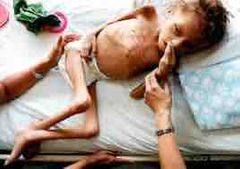
|
|
|
Infant mortality |
First year of life has highest mortality rate of any point in life span Neonatal death often result of severe birth defects, preterm birth, death of mother during childbirth Example: data from London, England, 1632 [2268 infants died] They want to open up more hospitals in case of emergencies as it is more common in developing countries. Things like Malaria (mosquito thing) and influenzas type B bacteria’s are dangerous. Also diarrhea is extremely dangerous because they leave the fluids they need (this explains why formula makes people 5 times likely to die since it’s used with unsafe water.) they can treat it with ORT oral rehydration therapy where they drink a salt and glucose mixed with clean water. (WHO reduced it from 4.5 million to half a million.) Rates of neonatal and infant mortality much higher in developing countries Differences in infant and maternal mortality based on SES, ethnicity Impact of vaccination of infant survival over past 50 years (eg polio, smallpox, measles, etc) this is the machine they put SpongeBob in. Immunization reduced small pox Cultural practices to protect infants Bali Indonesia believe infants should be shown respect similar to gods, since they recently arrived from spirit would where gods dwell, insufficient respect can cause an infant to decide to return to the spirit world Mongolian tradition if couple had lost a child give future children unpleasant names to make them less appealing to harmful spirits. Bali will make child not touch the ground for no spirits |
|
|
|
Gross motor development |
Motor abilities requiring coordination of large muscles groups, including balance and posture, as well as whole body movements such as crawling In the first year they hold their head up without support, roling over, sitting without support, crawling, standing, cursing (walking while holding on to something) and some walk. But when you hit the milestones varies a lot. Large cultural differences in how much adults stimulate early gross motor development (eg massaging, stretching limbs in Jamaica. Tummy time is now important for SIDS ), yet timing of development doesn’t reflect this variation. But Africans reach them faster Early gross motor development mostly ontogenetic (ie happens due to inborn, genetically based timetable) but after it’s both. Environment and genetics but genetics still the biggest one. Only exception is the Ache in South American Indian cultures who strap their babies to their mom. The who are strapped on the mom but have a delay if 1 year and walk at 2 years old but some day it’s because the babies like to be with the moms. Cultures with strapped babies may be slower but some face too many hazards in their home so they cannot practice even if they end up a bit slower. Some infants sit up right in a while before they would be able to in a hole. Some infants bounce the feet. |

|
|
|
Fine motor development |
Motor abilities involving fine hand and finger movements, opposable thumbs (what separates us from animals. The position of the thumb apart from the fingers, unique to humans, that makes possible fine motor movements like touching our own fingers), grasping reflex at birth, pre reaching reflex at 1 month (like swiping at something.), more accurate reaching at 3 months, grasping/lifting objects at 4-5 months, and by 9-12 months develop pincer grasp So at the end they can use a spoon at the end of the year. They can also pass one object to the other. Though they put it to their mouth. No one knows how it survived natural selection. |

|
|
|
Piagets theory of cognitive development review & assimilation, accommodation and equilibrium |
Stage theory; discontinuous development Changed driven by biological maturation (concept that an innate, biologically based program is the driving force behind development) when the 1 year old reaches age 4 the biological process helps Child plays active role in learning exploring environment. Think of how they react to reward and punishment They are all build in mental structures. Schemas/schemes: cognitive structures for processing, organizing, and interpreting information Assimilation: incorporating nee information into existing schemas (“doggie” to dog) Accommodation: changing existing schemas so that new information can be incorporated (Doggie to cat) Equilibrium: achieving a balance between assimilation and accommodation; achieved when new information successfully incorporated. The older they get they have the cognitive developmental approach (focus in how cognitive abilities change with age in stage sequence of development, pioneered by Piaget and since taken up by other researchers. |
|
|
|
Piagets sensorimotor stage |
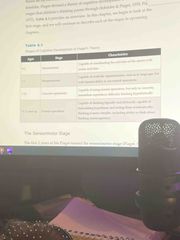
A-Not-B error: when infant watches an object be hidden in location A and has retrieved it, but then sees the object hidden in location B, infant we still look for object in location A. It’s weird because sometimes these issues happen in early childhood at 4-5 Object permanence happens at 4 months but at 4-8 months it gets better as they become suspicious and look at the blanket that covered the object briefly. Not long but at 8-12 months they start to lift up a blanket the covers a object they saw earlier. Some cultures reach it a bit earlier but it seems universal. Also remember they use assimilation a lot. So they don’t suck on random objects and they don’t smile at strangers. |
|
|
|
Language development & Cooing and babling, |
Cooing: pre-language “oo-ing”, “ah-ing”, and gurgling sounds infants make starting around 2 months of age Babbling: repetitive pre language consonant- vowel combinations (eg “ba-ba-ba” or “do-do-do”), starting around 6 months of age Same sounds used in babbling irrelevant of culture initially. So universal By 9months, babbling becomes language- specific. So they do it more to known sounds. Dead infants exposed to sign language will “babble with their hands” Quicker to learn object-labels if adult provides the word once the infant has started babbling. This hints they can start to have a conversation. By 8-10 months, start using gestures to communicate Often prompts adults to use words to describe infants behavioir/goal, helping word learning Language comprehension exceeds language production at all ages (as in we understand more then we can speak) First words usually said a few months beyond hitting 1 year old; May understand 50 words Usually first words are ma pa or hi or bye 4 month olds understand their name |
|
|
|
Infant directed (ID) speech |
Special form of speech adults in many cultures use with infants in which pitch voice is higher than usual and intonation is exaggerated with words and phrases repeated Infants pay more attention to infant-directed speech even in an unfamiliar language. They like it Exaggeration and repetition makes it easier for infants to understand; more emotionally charged than regular speech (as in they are friendly) Large cultural variation in how much parents speak to infants Even if infants not adress Ed directly, still surrounded by language and conversation, particularly in traditional cultures like Kenya. Some think it’s pointless because the baby doesn’t speak English. But it’s good to speak to them. But their are no consequences if they don’t They perfer it at month 4 |
|
|
|
Temperament & goodness of fit |
Temperament: inmate responses to environment; biological-based underpinnings of personality Eg. Irritability, smoothability, emotional reactivity, sociability Self regulation a common trait in temperament measures; ability to manage it inhibit initial responses to a situation Goodness-of-fit: theoretical principle that chuldten develop best if there is a good fit between the temperament of the child and the environmental demands Parents who are able to adapt to difficult child temperament help foster better outcomes than those who react with frustration and hostility Goodness-of-it for culture as well what traits are valued and praised vs seen as negative How traits link to outcomes such as school performance can vary by culture (shynesses is praised in China while in Canada it is not) |

|
|
|
Experiencing emotions |
Primary emotions: basic emotions such as anger, sadness, fear, disgust, surprise, and happiness; all evident within first year Secondary emotions: emotions that require social learning such as embarrassment, shame and guilt; also called sociomoral emotions; develop between ages 1 and 2 Distress, I treat and pleasure evident first differentiate over first months of life into the primary emotions Distress in 1 month olds is shown but they can’t show anger until 4 months old. They can show an even better mastery at 7 months old. Sadness is rare but a depressed mom can make a 2-3 month old show sadness which could be the result of passive genotype -> environment effect but non sad moms were experimented to look sad and the baby’s look sad so it’s a environment thing Fear is their at 6 months. They show fear facial expressions. It’s social (stranger anxiety) so they develop attachments. Surprise is shown by open mouth and raised eyebrows. Like a jack in the box because it violates expectations Happiness is shown in smiles and laughter in the first months. In a few weeks they smile in certain stimulation like peeing or having they cheek stroked. But second third month is when they have a social smile (a smile when interacting with others rather then a stimulus) German moms have more smiles so the infant has more social smiles then Nso infants |

|
|
|
Emotional perception |
Emotional contagion: crying in response to hearing another infant; starts within a few days of birth. Also they don’t cry when it’s a animal or a recording of a infant crying only an actual infant can trigger it. Hearing is much better at hearing. They try to look at sharp edges in faces so mouth and eyebrows By 2-3 months can distinguish between happy, sad, and angry facial expressions, and expect others to show emotional reactions to their behaviour; become upset when others are unresponsive (no emotion like the still face paradigm is when they know something is wrong) Social referencing: you know what this is but it’s present by 9-10 months |
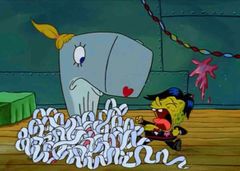
|
|
|
Cephalocaudal & Proximodistal principle |
These principles explain why growth is uneven during infancy. Cephalocaudal: growth begins at the top in the head then down in the body. Proximodistal: growth begins in the middle then outward |
|
|
|
Teething |
Beginning at around 9-15 months teething is a lot of discomfort getting your first teeth They become reluctant/hesitant to breast\bottle feed but they can finally eat solid foods. They also start to wake up middle of the night more and especially at 4 months (temporary). But their is strategies Like cold wet wash cloth or a teething ring can help by making them bite it in to relieve pain. Topical pain relievers rubbed on the gums can help. All remedies (like natural) are not always tested so check with a paediatrician so you don’t cause harm. |
|
|
|
Overproduction or synaptic exuberance |
The burst in dendritic connections between neurons. Few neurons connections at birth but grow hundreds by age 2. |
|
|
|
Brain parts and Lateralization |
Other brain parts that start to work are the the fore brain: limbic system (hypothalamus which is the size of a peanut, thalamus, and hippocampus.) and the cerebral cortex. Which is 85% of the brain weight (helps with concepts ideas and symbols). Laterization: Specialization of function in the two hemisphere of the brain. |
|
|
|
Sleep changes |
They don’t sleep as much as neonates but by 3-4 months they do end up sleeping more in a row rather then 16 hours at random times. They can sleep 6-7 hours in 1 go. Also Rem sleep is 40% down. But culture practises how much infants sleep like some American infants slept 14 hours a day and the ones strapped next to their mom slept 12 hours like in Kenya. The Dutch slept 14 hours so 2 hours more then Americans which is because they emphasize. (These cultures effects them at 6 months) |
|
|
|
Nutrition needs: introduction to solid food |
This age they need the most fat then any other age for the brain. Which breast milk has a lot of. Cultures vary for introduction to solid foods. Some do in after a few weeks and some in the second half of the first year. But most commonly it’s 4-5 months which is also when they can sit yo with support and begin to show interest in what others eat. But paediatricians recommend eating at 4-6 months. They ussualy want to introduce a unique food like rice with breast milk/formula or cereal and the second half then they can eat and digest carrots easily. In traditional cultures they use mashed up (pre chewed or pureed foods) In 4-5 months have a gag reflect which spits out food so they don’t end up eating that much. Chewing and swallowing doesn’t develop half the second half of the first year. |
|
|
|
Sensory development: depth perception |
Sight is the least mature Depth perception is developed in infancy so they can tell how far something is. They are helped by binocular vision. This is important because this is the age they walk. Think of the visual cliff experiment. The newly mobile decided to walk in the deep end. This is a bidirectional relation between perceptual and motor development. |

|
|
|
Sensory development: intermodal perception |
Intergration and coordination of information from the various senses. So a baby will try to touch hear and taste what a object sounds like a guitar. Neonates have something like that. They look where they hear something 1 month old infants can tell what they put their mouths but never seen. Visual and auditory can provide information. They can cordinate this pretty well even knowing a voice when they haven’t seen a face. |

|
|
|
Motor coordination & object permanence |
Since motor and cognitive development happen at the same time so when they fail at object permanence they may fail motor development to look for the object. Renée Baillargeon expirment Ed and saw that children up to 5-6 months though never went to look for the objects. When the object reappeared in a different spot they ended up looking at it way longer. Even 2-3 month old infants look more ay physically impossible phenomenons Peek a boo help eliminate it. The developmental happens sooner as the baby at 5 months smile before they see the face. At 12 months they can play the game themselves. Also this is in all animals. |
|
|
|
Information processing approaches |
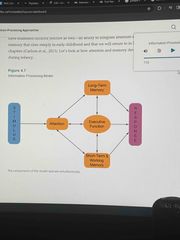
Instead of looking at it as discontinues the Information processing approaches (approaches to understanding cognitive functioning that focus on Cognitive processes that exist at all ages, rather than in viewing cognitive development in terms of discontinuous) which is more continuous. They try to see it in a computer for memory and processing. But the brain is far more complex. They use executive function (an ability to integrate attention and memory that rises in early childhood. It is in the graph |

|
|
|
Attention |
You know what habitation is but a infant will stop looking at a toy after a few glances. But dishabituation. Is following habituation on revival of attention when a new stimulus is presented. Like a face that is always showed the infant will look more at the new face. The heart rate declines when they see a new stimulus. At 4-5 months habituation takes 10 seconds while 7-8 months take a few seconds The ones who process information quickly habituate more quickly They get joint attention (the pointing thing) the 10 month old will not look or point where the blinded person pointed at. So they understand attention. Also since not all cultures encourage language. They use joint attention for help |
|
|
|
Memory |
Short term memory improved by the object permanence task. And where they look for objects in the second half of the first year. Long term 2-6 month old infants are taught that kicking their feet will move a mobile hanging. 2 months old forget while 6 month olds remember it for 3 weeks They showed distinction recognition memory and recall memory. So the infants understand retrieval cues but they don’t remember them. They recognize them but don’t remember |
|
|
|
Approaches to assessing development: the bayley scales |
Bayley scales of instant development (BSID-III) (widely used assessment of development from age 3 month to 3 and a half years. 1. Cognitive scale: ybis scale measures mental abilities such as attention and exploration. Ex: does a 6 month old look at a picture in a book; at 23-25 months it added whether a child can match similar pictures 2. Language Scale: measure use and understanding of language. Ex: if 17-19 months weather a child can identify objects; and at 38- 42 months it asses whether the child can name four colours 3. Motor scale: measures fine and motor abilities such as sitting alone for 30 seconds at 6 months or hopping twice on one foot at 38-42 months They produce a developmental quotient (DQ) as in a overall score for the infants. One who scores low will have a problem but it’s for for immediate attention rather then a predictor |
|
|
|
Approaches to assessing development: information-processing approaches to infant assessment |
Infants vary as it can be predicted with how quick they habituate. Which predicts their focus Short lookers have higher IQ scores and higher academic achievement as they develop because of their speed in information processing. So it makes habituation a better predictor |
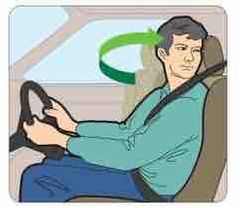
|
|
|
Can medios enhance cognitive development? The myth of “baby Einstein” |
A study in the 90’s listening to music of Mozart. It said to enhance cognitive function. The effect lasted 10 minutes and was used by college students Complete BS. No education DVD’s help. 8-16 month olds found that every hour they watched one. They understood 8-16 fewer words than babies who didn’t watch them. They had less social interaction so it was bad. Only 10% use it though. |
|
|
|
Temperament |
It’s a biological raw personality. So how kids act different from each other like attention span, sooth ability, and fearfulness |
|
|
|
Conceptualizing temperament {DONT LOOK AT HINT AS IT HAS THE ANSWER AS WELL} |
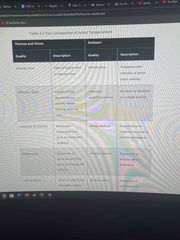
Temperment by Alexander Thomas and Stella chess was proposed Their are 3 types that parents helped make. 1. Easy baby (40%) can adapt well not a baby who’s a baby about situations 2. Difficult babies (10%) negative ah 3. Slow to warm up babies (15%) Prince Zuko type character development. 35% could not be classified. (So now they use traits instead of categories) It did predict problems in the future for the negative ones like anxiety, aggression and social withdrawal. But the slow to warm up didn’t have much issues in early childhood except when they entered school which they were fearful and issues academically and peers also slow responsively. Mary Rothbart and Thomas Chess said that some infants will look T their parents to see how they should respond to something. |
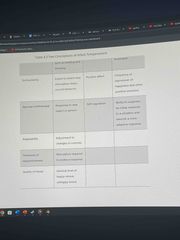
|
|
|
Goodness of fit |
Goodness of fit is a idea proposed by Thomas and chess which is a theoretical principle that children develop best if there is a good fit between the Temperament of the child and environmental demands. So basically the parent adapts with the kids Temperament being patient in nurturing This is supported. The negative babies could control their emotions better. Those who use obedience will get a child who is disobedient Cultures also influences as they regulate their emotions like how Asians being quiet. |
|
|
|
Cultural themes of infant social life |
These come frequently among cultures 1. Infants are with their mothers almost constantly during the early months of life (1-6 months) they both recover together and this is the strap 2. After about 6 months most daily infant care is fine by older girls rather than the mother. Usually 6-10 year old takes care but usually a sister but the infant returns to sleep with the mom. 3. Infants are among many other people in the course of a day. Basically they chill with the fam and randoms 4. Infants are held or carried almost constantly. In traditional culture they don’t touch the ground because they have to be safe. 5. Fathers are usually remote or absent during the first year. Most cultures don’t let the father see the infant. This is also because of gender roles and because the mom breast feeds In developed countries is different especially in the western country. Usually we now look at the nuclear family like parents and kids. The infant is left alone in a room. Fathers are more involved. But Moms are more. They get capable to be social. |
|
|
|
Foundation of social development: two theories |
Erik Erikson proposed a eight stage theory of the life span with a “crisis” for each stage. Like trust and mistrust Trust and mistrust: the first stage of development during infancy in which the central crisis is the need to establish a stable attachment to a loving and nurturing caregiver. So know they can be taken care of. So more emotional bond If this is met then they will trust others and if not then they will mistrust others and the caregiver. So they will be effected later on. So it’s problematic for later stages John Bowlby another influential figure made the attachment theory Attachment theory: a theory of emotional and social development focusing on the crucial importance of the infants relationships with the primary caregiver. And same thing. If the trust is not Met. So the sensitive and responsive criteria is not met then their social relationships in the future is doomed But this is a contrast of psychosexual stages . This helped thousands of studied on toddlers and animal species relationships |
|
|
|
Onto genetic |
A timetable of when one reaches motor and gross skills |
|

